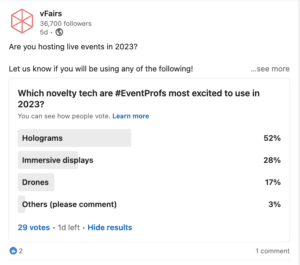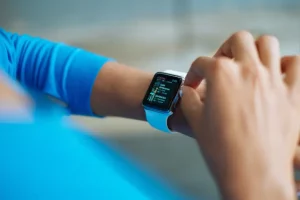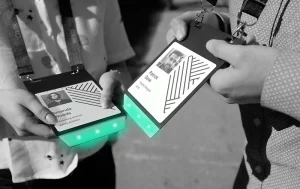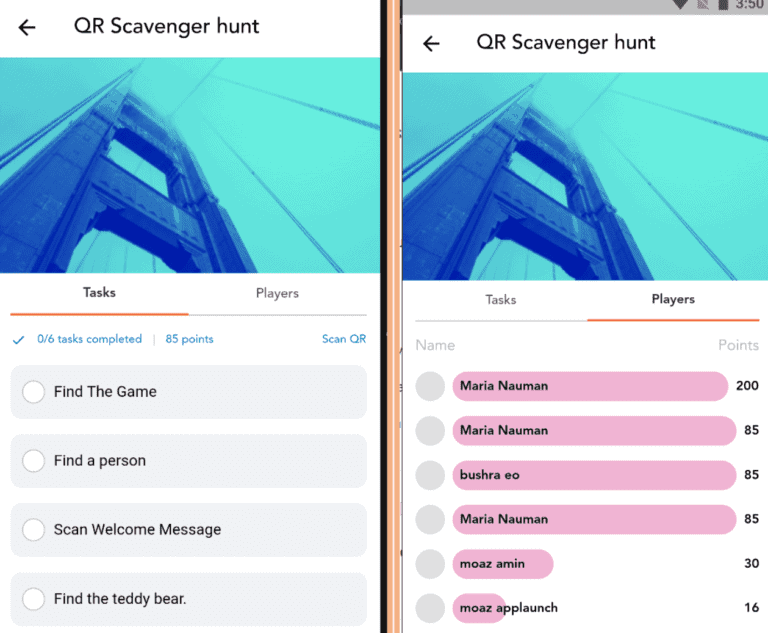Technology has changed at an amazing rate in the events industry in the past few years. As a result, companies now invest a lot in technologies that improve user experiences and make events better and better.
Nowadays, organizers use technology in every step of the process, from registration to measuring the ROI. Live event technology will remain in the talks in 2023, see the survey result. 
Businesses are investing in-event technology and streamlining processes for every stakeholder involved. vFairs, one of the leading event management companies, also offers powerful event technology to help you provide the best experience for your attendees.
Chapter 1: The Importance of In-Person Event Technology

Event technology is changing faster than ever, and for a good reason. The events industry is becoming more and more digital. If we want our event marketing to do well, we need to keep up with the latest trends.
Today, the majority of people who work in the event industry agree that technology can make their events better. Here’s how:
- Event technology allows attendees to communicate with one another before, during, and after the event, making networking easier than ever.
- Event apps make it much easier for organizers to alert participants to any potential schedule changes.
- You can also install chatbots that respond to inquiries regarding the occasion.
- Another significant advantage of event technology is the availability of data insights and analytics reports for organizers. They can monitor customer behaviors, lead generation, revenue, and other things.
Chapter 2: Benefits of Using Technology In Your Events
Event technology has various benefits for all stakeholders involved. Let’s dig deeper into what it has to offer to exhibitors and attendees.
For Exhibitors
- At different points in the planning process, event technology can make things easier for exhibitors and give them back some of their time.
- One of the best things about event technology is that it helps exhibitors get data insights and analytics reports. Exhibitors can keep track of how customers act, how many leads they get, how much money they make, and more.
- Event technology saves organizers a lot of stress, time, and energy because it automates many processes, such as registration, catering, and measuring event ROI.
- The technology is error-free, which helps people make fewer mistakes. Exhibitors no longer have to worry about any math or small tasks that accompany an event.
For Attendees
- Attendees can use a mobile app for an event to get all relevant information, communication, notifications, and content.
- Attendees can also let exhibitors and sponsors know they are interested in them before the event and set up meetings.
- The self-check-in kiosks let people check-in without touching anything.
- Event technology lets attendees message before, during, and after the event, making networking easier.
Chapter 3: Types of In-Person Event Technology
When planning an event, technology is essential. The key to success in today’s meeting and event planning industry is not adopting old-fashioned ways, but instead using appropriate technologies at the right moment.
Mobile Apps

One of the most exciting developments in the event industry is the rise of mobile event applications, which you can utilize in various ways to improve productivity and enhance the experience of event attendees. Initially, event apps facilitate information dissemination and permit more eco-friendly event operations. You can minimize paper waste and lessen the environmental effect of your event by making announcements, session details, speaker biographies, exhibitor details, and resources all available digitally.
Wearables
Wearables can provide valuable data and indeed provide a fun element to an event. Smart badges and RFID bracelets help track participants’ movements and gather information about how they interact with booths and activations.

More recently, eyewear that enables users to record events using display technologies like augmented reality has become popular, allowing marketers to communicate in novel and engaging ways.
You can use wearables to monitor the traffic at your conference and learn where people cluster, what sessions they take advantage of, and which booths they peruse. You can compile this information into big data to help you make your event better. Further monetizing events, wearables can also replace traditional paper tickets by serving as a means of payment for goods and services.
Event Marketing Technology
Event marketers know that they need to give attendees something of value and match their needs with valuable products, services, and information. When planning your event, you also need to find new ways to reach attendees, get their attention, and make the event fit their specific interests. You can do this with the help of online event tech.
Email marketing tools like MailChimp and HubSpot are great for getting in touch with your attendees more personally. You can use personalized emails, texts, and push notifications from the event app to get people excited about the event. You can also change the way you use social media to market to create more intrigue. Landing pages and registration forms also help you promote the event. They help to get more people to register for the event!
Moreover, you’ll have a better chance of getting people to come to your event if you address their problems and talk about things they’re interested in.
Check-In Software

You can communicate safety protocols and register at checkpoints online with event tech. Typically, you would have attendees line up at a registration desk. Some members of your organizing team will check in attendees. You would also need a system for printing badges. You could get them printed ahead of time or at check-in. However, you can automate all of these processes with an event check-in app.
Most of the time, you can add event check-in software to an event app or into a separate app. Either way, you can ask your guests to download the app, making the event check-in process quick and easy.
Floorplans
A practical event floor plan layout is crucial to directing visitors’ attention in the right direction. You may improve engagement and prevent a bad experience for the attendees by knowing how to arrive at the ideal design and ensuring your venue follows the plan.
With the use of event technology, you can design an interactive map that replicates the actual floorplan and make it easier for attendees to find the locations they need.
Event Engagement & Gamification Technology

Gamified events are the next big thing regarding event technology. Gamification is all about using games to give attendees a fun, immersive experience while also bringing new leads and people to the exhibitors’ booths. You can use interactive games like digital quizzes, polls, scavenger hunts, and trivia games at your event to get people excited and interested.
Practically, everyone likes games, so gamification is an excellent way to boost engagement at your event. Attendees get to interact and connect. You can also incentivize people to participate and then reward them with points.
Event Reporting
Before there were event apps and platforms, event planners used surveys before and after the event to measure the return on investment (ROI). Such calculations rarely accurately predicted how well an event did because the open rates rarely reached statistically significant percentages.
Since then, the game has changed. One of the best things about event technology is that it can help you get data insights and analytics reports. Planners need to find the right piece of technology that gives them the right analytics so they can measure the event KPIs that matter for their event. They can track customers’ behavior, lead generation, revenue and more.
Chapter 4: How To Incorporate In-Person Event Technology At Your Events
It’s time for a change if you want to streamline your events and host successful events anywhere in the world. You require flexible technology that can grow as your needs do. Here are a few tips to help you incorporate event technology into your plan seamlessly.
1. Invest in Tools That Support Your KPIs
The first step is to determine your goals and objectives. You need to have a clear understanding of your needs. Instead of blindly investing in different types of event technology platforms, you must ensure that you are investing in the tools you actually need.
2. Create An Event Planner
The next step is to create an agenda. You need to decide which technology you need and when you need it. For example, the registration form for your event will serve as the first impression of your event technology for your guests. Because of this, you should find event tech that includes easy-to-use registration forms that fit with your brand.
3. Do Your Research
Before incorporating any event tech into your event management plan, you need to do your homework. A well-researched purchase will benefit you in the longer run, considering you will keep in mind all the pros and cons while making a decision.
4. Shortlist Your Options
Once you have researched which event technology tools you need, it’s time to shortlist your options. See which options fit into your budget and which ones are worth investing in, considering your event requirements.
5. Ask For Demonstrations
When you have finally shortlisted your options, it’s best to reach out to the vendors and schedule a demo. A demo is a real-time setting where you can explore the tools thoroughly. You will be able to analyze them and see which ones to finalize.
6. Choose Which Features You Want
Once you have chosen an event tech platform, it’s time to decide which features you require. For example, you can choose the tools you need from the vFairs VenueGear.
7. Work Out a Payment Plan
The final step is to work out a payment plan. You can contact the vendors for detailed pricing plans and then see which ones fit your budget.
Chapter 5: Top Questions To Ask Your Event Technology Providers
Here are a few questions you should ask your event technology provider before making a purchase. The answers will help you make a more knowledgeable decision considering all the pros and cons.
What Do You Offer?
The first and foremost question is to ask about the event technology offerings. You need to make sure that the providers fulfill all your requirements as it is not a minor investment.
What is the Pricing?
The pricing plans vary depending on each feature. However, you know your requirements better so, it’s always a great idea to have a pricing plan in mind while considering various options.
Delivery Timeline?
Suppose you have an upcoming event that will be an excellent opportunity for you to showcase your event technology. However, you are not sure whether you will have access to the technology by then or not. Therefore, it’s better to be clear about the delivery timeline to avoid misunderstandings.
How Will the Responsibilities and Logistics Be?
Last but not least, you need to clearly understand the responsibilities and logistics associated with the event technology. It’s always great to have a plan instead of panicking at the eleventh hour!
Chapter 6: What Does vFairs Offer?
If you’re hosting an event, vFairs VenueGear can help you streamline everything from user registration to badge printing and attendance tracking, giving you a clear picture of how your guests are interacting with your brand and the event. Here’s a complete list of vFairs in-person technology features.
Registration/Ticketing
This service gives you a landing page that you can design yourself, as well as pre-event registration, ticketing, and payment collection. It will show all the reports about who signed up for the event and give attendees a confirmation of their registration or a ticket so they can easily check-in and get in on the day of the event. You wouldn’t have to deal with manual signups on your end because vFairs have got you covered. The following services are part of this feature:
- Custom-designed landing page
- Customized sign-up form (attendee)O
- optional custom form for exhibitors
- Pricing page with different levels of packages
- Payment capture & integrations
- Pre-event email marketing tools
- CRM integration
- Attendee Management Interface
Below, you can see how a custom landing page and registration work.

Mobile App

During the event, people can use the vFairs mobile app to chat, look for other exhibitors, share their business cards virtually, and check in. This makes it possible for people to take part in live events from anywhere in the world. Attendees can also customize their schedules and choose which sessions to add. They can also add it to their calendars to make sure they don’t miss any important talks that day. If your attendees can’t make it to a session they wanted to go to, they can watch a replay in the app whenever they want.
Check-In Gear
This service makes it easy to check in at a live event because you don’t have to check the registration or payments by hand. If payment has already been made through the registration site, attendees will get a QR code that they can scan at the venue to self-check in. Or, if you want to check the person yourself, you can scan a QR code to confirm their registration. You can also give each person a printed name tag. This will make it easy for people to check in at the event. The picture shows how the choice will look.
QR Scavenger Hunt
Your in-person event guests will surely love the vFairs QR Scavenger Hunt. At the event, participants look for items labeled with a QR code, scan the code using the vFairs mobile app’s scanner, and get points for each item they find. At vFairs, you can modify the QR Scavenger Hunt with little effort. On the administrative end, you can assign points to as many different things as you choose.

Badge Printing and Lanyards
This service lets people make their own badges in real time so that they can be easily tracked and identified. vFairs can help you get all set up with:
- badge printer
- wireless router
- ethernet network switch: a device that connects two networks.
This will save you the trouble of making badges and trackers by hand. There will be different types of lanyards and badges:
- Premium/Standard Event Badge
- Premium/Standard Lanyard
- Stick-on labels for badges
The picture shows how personalized badges and lanyards will look.

Other Features
The vFairs VenueGear bundles come with extras like an onsite social media wall, photo booth, and leaderboard station. This will add a new dimension of excitement and entertainment to your gathering. The specials include the following features:
- Video Wall + LCD for Social Media
- (Camera + LCD) Photo Booth
- Display Board with Top Performers

Conclusion
Technological advances in event management have the potential to greatly improve the experience for those involved. Technology makes your job easier and lets you pay attention to what’s most important at an event. It helps with everything from making sure that individuals are satisfied to keeping track of projects, so try it out at your next event.
We, at vFairs, offer all the event technology features you need to streamline your next event. Contact us to schedule a demo and learn more about our VenueGear.


